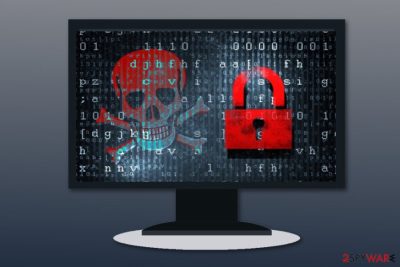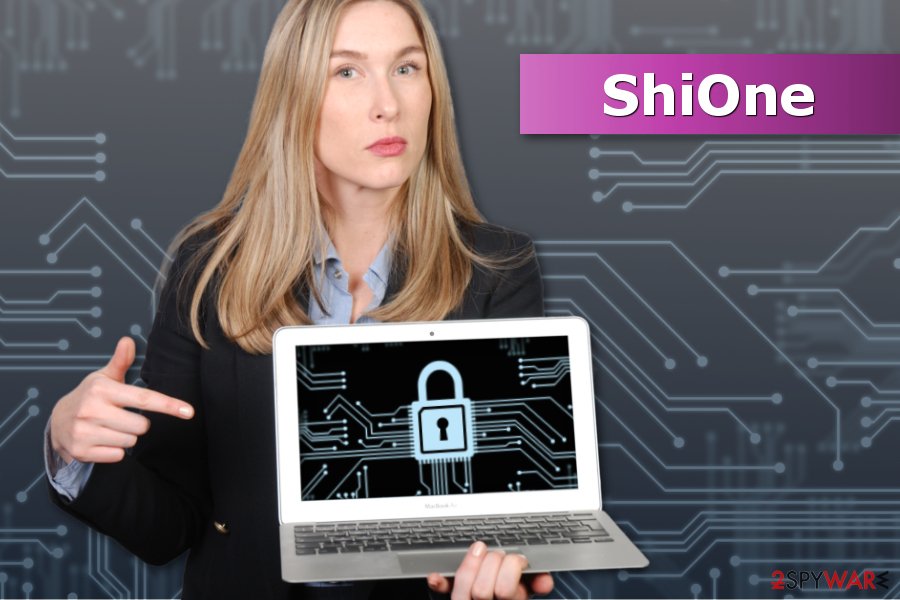ShiOne ransomware (Virus Removal Instructions) - Decryption Methods Included
ShiOne virus Removal Guide
What is ShiOne ransomware?
ShiOne – a cyber threat that encrypts important files on the targeted computer

ShiOne is a ransomware virus that is designed to encrypt files on the targeted computer. The malicious program uses a combination of RSA and AES encryption[1] to make documents, images, multimedia, archives, databases, and other popular data inaccessible.
ShiOne ransomware is written in C# programming language and generates data encryption keys offline. It means that they are added in the ransomware’s code before distributing the virus. Malware can be spread via malicious spam email attachments, infected ads, bogus download, etc.
However, once ShiOne virus enters the system, it modifies Windows settings, created new Registry entries and might install numerous components that are responsible for keeping ransomware on the computer and data encryption.
ShiOne uses symmetric and asymmetric keys to encrypt files on the affected computer. Following the complicated encryption procedure,[2] malware drops a ransom note where victims are asked to pay the ransom in exchange for decryption software.
However, we want to discourage you from transferring the demanded sum of money. This action might only increase your loss. Ransomware-type cyber threats are created for swindling the money only. No one can ensure you that cyber criminals actually have working ShiOne decryptor and let you use it after receiving your payment.
Instead of risking to lose your money, you should remove ShiOne from the computer. Virus elimination is needed to protect your machine from further cyber attacks or privacy-related issues. Also, while malware resides on the system, your PC is sluggish, and some of the programs might not operate properly.
As soon as you learn about ransomware attack, you should scan the system with reputable anti-malware software, such as FortectIntego. However, automatic ShiOne removal won’t help to recover your files. For that, you will need to use data backups or third-party tools. You can find some suggestions below.

Ransomware distribution methods and how to avoid it
Crypto-viruses can be distributed using numerous methods. The most popular way to spread file-encrypting viruses is spam emails that contain the attached document. Nevertheless, the attachment looks like ordinary Word, PDF or ZIP file; it is obfuscated and includes malware downloader. Once you click it, malware executable is dropped on the PC.
However, there are many other crypto-malware distribution strategies. Security specialists from bedynet.ru[3] tell that users should be careful with software downloads or updates installation. Freeware, shareware and update alerts in pop-ups often include malicious content. Users are advised not to install any cracked or illegal content.
Additionally, authors of ransomware virus might take advantage of these distribution methods too:
- malware-laden ads that might be placed on legit and high-risk websites;
- exploit kits that take advantage of outdated software or operating system vulnerabilities;
- drive-by downloads that trick users into installing fake browser extensions or software.
Security experts remind that even the most secure antivirus program cannot protect you from ransomware if you do not watch your activities online. Additionally, you should create backups of the important files in case of the cyber attack.
Delete ShiOne ransomware from the machine
To remove ShiOne from the computer, you have to obtain a reputable malware removal software. Ransomware is a complex cyber threat that consists of numerous files and programs. Additionally, it can compromise important system processes. So, attempts to fix malware’s damage manually might not end up good.
To avoid damaging the computer and deleting crucial system files, you have to use FortectIntego, Malwarebytes or other malware removal software. If you cannot run automatic ShiOne removal, follow the steps below to disable the virus first.
Getting rid of ShiOne virus. Follow these steps
Manual removal using Safe Mode
If ShiOne blocks access to security software, follow these steps to disable the virus:
Important! →
Manual removal guide might be too complicated for regular computer users. It requires advanced IT knowledge to be performed correctly (if vital system files are removed or damaged, it might result in full Windows compromise), and it also might take hours to complete. Therefore, we highly advise using the automatic method provided above instead.
Step 1. Access Safe Mode with Networking
Manual malware removal should be best performed in the Safe Mode environment.
Windows 7 / Vista / XP
- Click Start > Shutdown > Restart > OK.
- When your computer becomes active, start pressing F8 button (if that does not work, try F2, F12, Del, etc. – it all depends on your motherboard model) multiple times until you see the Advanced Boot Options window.
- Select Safe Mode with Networking from the list.

Windows 10 / Windows 8
- Right-click on Start button and select Settings.

- Scroll down to pick Update & Security.

- On the left side of the window, pick Recovery.
- Now scroll down to find Advanced Startup section.
- Click Restart now.

- Select Troubleshoot.

- Go to Advanced options.

- Select Startup Settings.

- Press Restart.
- Now press 5 or click 5) Enable Safe Mode with Networking.

Step 2. Shut down suspicious processes
Windows Task Manager is a useful tool that shows all the processes running in the background. If malware is running a process, you need to shut it down:
- Press Ctrl + Shift + Esc on your keyboard to open Windows Task Manager.
- Click on More details.

- Scroll down to Background processes section, and look for anything suspicious.
- Right-click and select Open file location.

- Go back to the process, right-click and pick End Task.

- Delete the contents of the malicious folder.
Step 3. Check program Startup
- Press Ctrl + Shift + Esc on your keyboard to open Windows Task Manager.
- Go to Startup tab.
- Right-click on the suspicious program and pick Disable.

Step 4. Delete virus files
Malware-related files can be found in various places within your computer. Here are instructions that could help you find them:
- Type in Disk Cleanup in Windows search and press Enter.

- Select the drive you want to clean (C: is your main drive by default and is likely to be the one that has malicious files in).
- Scroll through the Files to delete list and select the following:
Temporary Internet Files
Downloads
Recycle Bin
Temporary files - Pick Clean up system files.

- You can also look for other malicious files hidden in the following folders (type these entries in Windows Search and press Enter):
%AppData%
%LocalAppData%
%ProgramData%
%WinDir%
After you are finished, reboot the PC in normal mode.
Remove ShiOne using System Restore
This method might also help to run automatic malware removal smoothly:
-
Step 1: Reboot your computer to Safe Mode with Command Prompt
Windows 7 / Vista / XP- Click Start → Shutdown → Restart → OK.
- When your computer becomes active, start pressing F8 multiple times until you see the Advanced Boot Options window.
-
Select Command Prompt from the list

Windows 10 / Windows 8- Press the Power button at the Windows login screen. Now press and hold Shift, which is on your keyboard, and click Restart..
- Now select Troubleshoot → Advanced options → Startup Settings and finally press Restart.
-
Once your computer becomes active, select Enable Safe Mode with Command Prompt in Startup Settings window.

-
Step 2: Restore your system files and settings
-
Once the Command Prompt window shows up, enter cd restore and click Enter.

-
Now type rstrui.exe and press Enter again..

-
When a new window shows up, click Next and select your restore point that is prior the infiltration of ShiOne. After doing that, click Next.


-
Now click Yes to start system restore.

-
Once the Command Prompt window shows up, enter cd restore and click Enter.
Bonus: Recover your data
Guide which is presented above is supposed to help you remove ShiOne from your computer. To recover your encrypted files, we recommend using a detailed guide prepared by 2-spyware.com security experts.If your files are encrypted by ShiOne, you can use several methods to restore them:
Try Data Recovery Pro to restore encrypted files by ShiOne
Data Recovery Pro is designed to recover files after system wreckage or accidental deletion. However, it can also help to restore some of the encrypted files too.
- Download Data Recovery Pro;
- Follow the steps of Data Recovery Setup and install the program on your computer;
- Launch it and scan your computer for files encrypted by ShiOne ransomware;
- Restore them.
Try Windows Previous Versions feature
If System Restore was enabled before ransomware attack, you can follow these steps and recover individual files:
- Find an encrypted file you need to restore and right-click on it;
- Select “Properties” and go to “Previous versions” tab;
- Here, check each of available copies of the file in “Folder versions”. You should select the version you want to recover and click “Restore”.
Try ShadowExplorer software
If ransomware did not delete Shadow Volume Copies, this tool can help you:
- Download Shadow Explorer (http://shadowexplorer.com/);
- Follow a Shadow Explorer Setup Wizard and install this application on your computer;
- Launch the program and go through the drop down menu on the top left corner to select the disk of your encrypted data. Check what folders are there;
- Right-click on the folder you want to restore and select “Export”. You can also select where you want it to be stored.
ShiOne decryptor is not available.
Finally, you should always think about the protection of crypto-ransomwares. In order to protect your computer from ShiOne and other ransomwares, use a reputable anti-spyware, such as FortectIntego, SpyHunter 5Combo Cleaner or Malwarebytes
How to prevent from getting ransomware
Access your website securely from any location
When you work on the domain, site, blog, or different project that requires constant management, content creation, or coding, you may need to connect to the server and content management service more often. The best solution for creating a tighter network could be a dedicated/fixed IP address.
If you make your IP address static and set to your device, you can connect to the CMS from any location and do not create any additional issues for the server or network manager that needs to monitor connections and activities. VPN software providers like Private Internet Access can help you with such settings and offer the option to control the online reputation and manage projects easily from any part of the world.
Recover files after data-affecting malware attacks
While much of the data can be accidentally deleted due to various reasons, malware is one of the main culprits that can cause loss of pictures, documents, videos, and other important files. More serious malware infections lead to significant data loss when your documents, system files, and images get encrypted. In particular, ransomware is is a type of malware that focuses on such functions, so your files become useless without an ability to access them.
Even though there is little to no possibility to recover after file-locking threats, some applications have features for data recovery in the system. In some cases, Data Recovery Pro can also help to recover at least some portion of your data after data-locking virus infection or general cyber infection.
- ^ AES and RSA Encryption. Boxcryptor. Encryption software to secure cloud files.
- ^ Vasilios Hioureas. Encryption 101: ShiOne ransomware case study. Malwarebytes blog. Security blog.
- ^ Bedynet. Bedynet. Russian cyber security news.





















